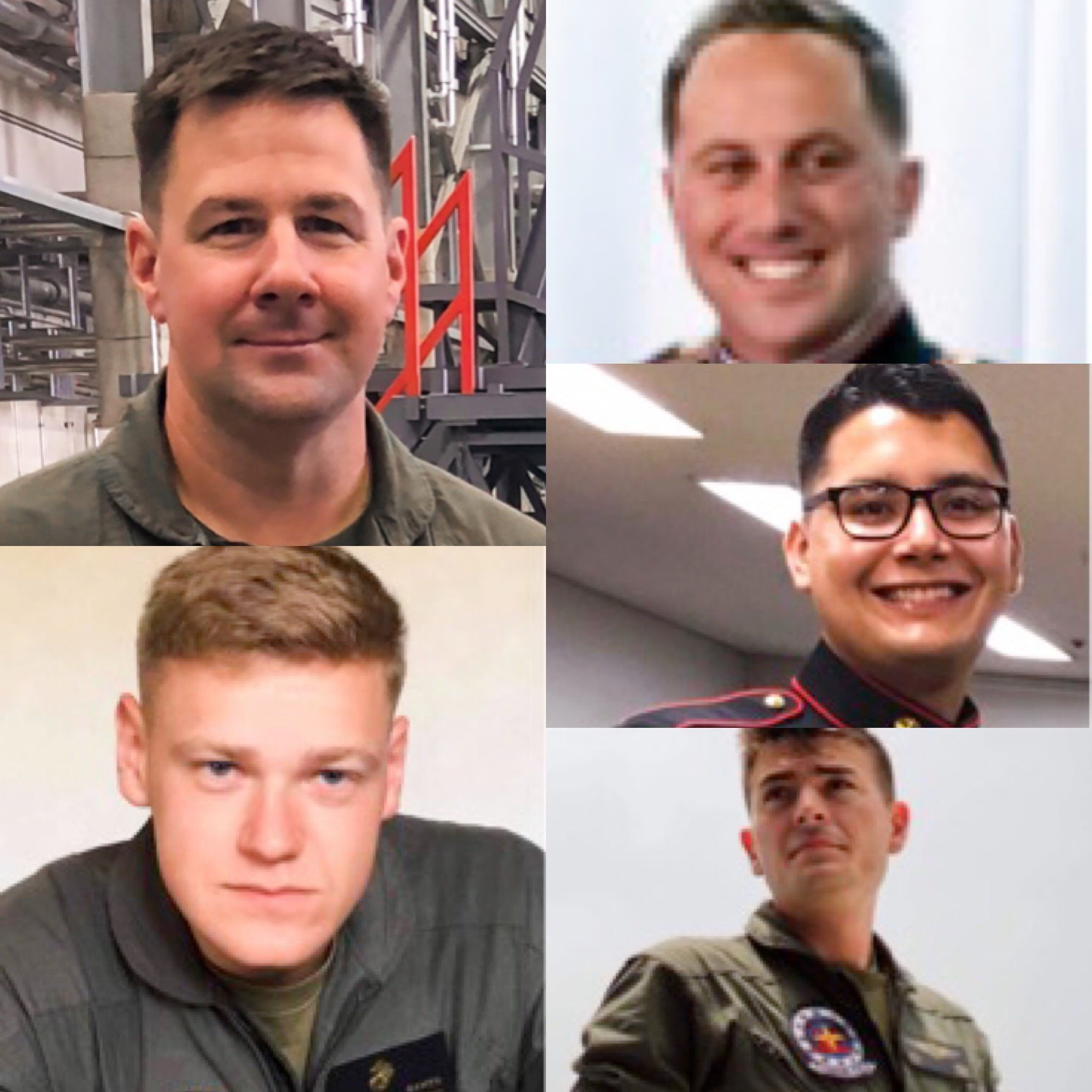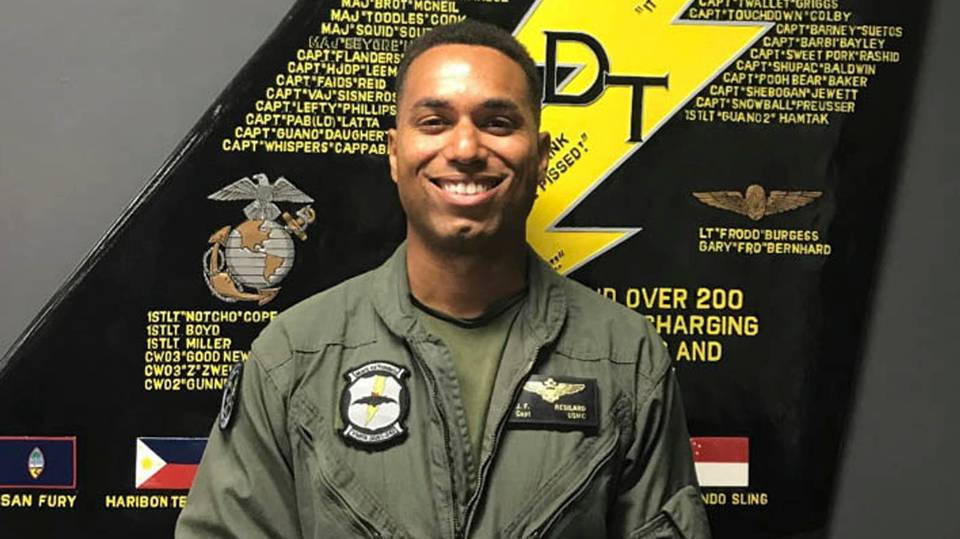
A review of two previous Marine Corps aviation mishaps and their subsequent command investigations concludes that “organizational culture and command climate” contributed to both a 2016 and 2018 mishap within 1st Marine Aircraft Wing in Japan – and it adds that some conclusions made by the chain of command regarding the fatal 2018 crash were inaccurate or misleading.
In 2018, an F/A-18D Hornet aircraft from Marine All-Weather Fighter Attack Squadron 242 and a KC-130J Super Hercules aircraft from Marine Aerial Refueler Transport Squadron 152 collided off the coast of Japan during a nighttime refueling, killing all five Marines on the KC-130J and the pilot of the Hornet. The weapons system officer on the jet survived. In 2016, aircraft from these same two units were involved in another refueling mishap, though no one was injured.
The Marine Corps conducted an investigation after the fatal crash, which found that pilot error, inadequate oversight of training and operations and an unprofessional command climate contributed to the crash. The investigation repeatedly noted the Hornet pilot’s inexperience and suggested that two aviators had sleep aid Ambien and cold medication in their systems, making them “not medically fit for flight duties at the time of the mishap” – though the names of the two aviators are redacted.
Just days after this investigation was released, though, Assistant Commandant of the Marine Corps Gen. Gary Thomas appointed an independent Consolidated Disposition Authority to review both cases, to bring him an outside view of the situation rather than just the mishap investigations that are conducted within the affected unit’s chain of command.
That CDA reported back to Thomas last month. Military.com first reported this week on the findings that the command investigation was flawed.
“The CDA-RB (consolidated disposition authority review board) determined the previous 2018 mishap command investigation did not capture a completely accurate picture of the event. The CDA-RB determined portions of the investigation contained a number of inaccuracies. Specifically, the 2018 command investigation incorrectly concluded medication may have been a causal factor in the mishap, the mishap pilot was not qualified to fly the mission, AN/AVS-11 night vision devices contributed to the mishap, and the previously mentioned mishap in 2016 had not been properly investigated. These conclusions are not supported by the evidence, and are addressed in detail in the CDA-RB report,” reads a Marine Corps news release.

The news release offers a somewhat different account of the moments leading up to the fatal collision: the initial command investigation placed the onus on the Hornet pilot, Capt. Jahmar Resilard, saying he was inexperienced, requested to make a non-traditional move away from the KC-130J after refueling, lost situational awareness and collided with the back of the tanker. The CDA, on the other hand, made clear that another Hornet participating in the training event made the first non-traditional move and then turned its bright outer lights on, hindering Resilard’s ability to focus on the dimly lit tanker and putting him in a position that few pilots could have successfully managed, regardless of skill and experience.
The command investigation wrote: “At approximately 1:30 a.m. on December 6, 2018, while flying at an altitude of 15,000 feet, two F/A-18Ds assigned to VMFA(AW)-242 joined a KC-130J assigned to [Marine Aerial Refueler Transport Squadron 152] for air-to-air refueling. The first F/A-18D (F/A-18 Flight Lead) completed refueling and moved to a position on the right side of the KC-130J (Right Echelon). After the second F/A-18D completed refueling, its pilot requested and was approved to move to the left side of the KC-130J (Left Echelon), a non-standard maneuver for air-to-air refueling departure procedures. The pilot of the second F/A-18D was not experienced in conducting nighttime air-to-air refueling operations. The investigation indicates the mishap pilot lost situational awareness, unintentionally crossed over the top of the KC-130J from left to right, and collided with the rear of the tanker.”
According to the Marine Corps statement today: “The CDA-RB’s report determined four interconnected causal factors led to the 6 December 2018 mishap. First, the flight lead (F/A-18 call sign, Profane 11) requested, and received approval for, an un-briefed, non-standard departure from the C-130 tanker (call sign, Sumo 41). This departure placed the mishap pilot (F/A-18 call sign, Profane 12) on the left side of the tanker. A standard departure would have placed both F/A-18s on the right side of the tanker. Second, Profane 11 chose an authorized, but not optimized, lighting configuration. After tanking, Profane 11 placed his external lights in a brightly lit overt setting, while the C-130’s lights remained in a dimly lit covert setting. These circumstances set the conditions for Profane 12 to focus on the overtly lit Profane 11 aircraft, instead of the dimly lit tanker. Third, Profane 12 lost sight of the C-130 and lost situational awareness of his position relative to the tanker resulting in a drift over the top of the C-130 from left to right. Fourth, Profane 12 was unable to overcome these difficult and compounding challenges created by the first three factors. As a result, when Profane 12 maneuvered his aircraft away from Profane 11, he moved from right to left and impacted the right side of the tanker’s tail section. It must be noted, this specific set of circumstances would have been incredibly difficult for any pilot, let alone a junior, or less proficient pilot to overcome.”
The crash killed all five Marines on the KC-130J: Lt. Col. Kevin Herrmann, 38, of New Bern, N.C.; Maj. James Brophy, 36, of Staatsburg, N.Y.; Staff Sgt. Maximo Flores, 27, of Surprise, Ariz.; Cpl. Daniel Baker, 21, of Tremont, Ill.; and Cpl. William Ross, 21, of Hendersonville, Tenn; as well as the Hornet pilot, Capt. Jahmar Resilard, 28, of Miramar, Fla. The weapons system officer ejected from the jet immediately after the collision and was rescued by Japanese naval forces.
The CDA review board made 42 recommendations to address institutional and organizational contributing factors, and ACMC Thomas directed 11 actions to address manpower management, training, operations, and medical policies.
On manning, since the Marine Corps is in the midst of transitioning from the Hornet and the AV-8B Harrier to the F-35B and C Joint Strike Fighter, Thomas wrote in a letter accompanying the CDA final report that all three aircraft types’ training pipelines and duty assignment processes would be reviewed. Additionally, going forward, the most talented first-tour aviators would be sent to the most challenging assignments in forward-deployed squadrons, which hadn’t been the case before.
On training, the F/A-18 training and readiness manuals, standard operating procedures and aerial refueling directives would be updated and standardized.
Thomas also calls for a Search and Rescue Working Group to examine Japanese SAR capabilities and agreements with U.S. forces and make any adjustments needed. The Marines would also field an automatic crew electronic location device to help SAR teams find any missing Marines.
The letter also requests a Department of Navy Aviation Sleep Management Study, with operations policies being adjusted as needed based on the outcome of the study. And guidance would be updated related to controlled and over-the-counter drugs.
Below is the full statement from the U.S. Marine Corps:
Consolidated Disposition Authority Review Board Report on 2016 and 2018 Aviation Mishaps
WASHINGTON D.C. — On 18 June 2020, the Assistant Commandant of the Marine Corps provided the institution’s review and position on the Consolidated Disposition Authority Review Board’s (CDA-RB’s) report that looked into two separate aviation mishaps. On 6 December 2018, a midair collision between an F/A-18D Hornet aircraft from Marine All-Weather Fighter Attack Squadron 242 and a KC-130J Super Hercules aircraft from Marine Aerial Refueler Transport Squadron 152 occurred off the coast of Japan shortly after aerial refueling. Six Marines died in this incident and two aircraft were lost. On 28 April 2016, a less severe mishap with no injuries or aircraft loss occurred after aerial refueling between the same two squadrons. Both squadrons are assigned to 1st Marine Aircraft Wing, the aviation combat element of III Marine Expeditionary Force. The Marine Corps subjected the command investigations into these mishaps to further review.
The Consolidated Disposition Authority (CDA), as an independent commander, appointed a review board on 3 October 2019. The CDA was authorized to order a range of actions to include further investigation and/or administrative or disciplinary action in accordance with the Uniform Code of Military Justice. Where the previous command investigations were conducted by a single individual, the appointed review board was comprised of twelve experts from the F/A-18, MV-22, C-130, maintenance, medical, and legal communities. The CDA-RB’s intent was to enumerate every contributory and casual factor, allowing the institution to hold accountable those who should be held accountable, and provide appropriate, workable, and implementable recommendations for the institution to consider going forward.
The CDA-RB’s report determined four interconnected causal factors led to the 6 December 2018 mishap. First, the flight lead (F/A-18 call sign, Profane 11) requested, and received approval for, an un-briefed, non-standard departure from the C-130 tanker (call sign, Sumo 41). This departure placed the mishap pilot (F/A-18 call sign, Profane 12) on the left side of the tanker. A standard departure would have placed both F/A-18s on the right side of the tanker. Second, Profane 11 chose an authorized, but not optimized, lighting configuration. After tanking, Profane 11 placed his external lights in a brightly lit overt setting, while the C-130’s lights remained in a dimly lit covert setting. These circumstances set the conditions for Profane 12 to focus on the overtly lit Profane 11 aircraft, instead of the dimly lit tanker. Third, Profane 12 lost sight of the C-130 and lost situational awareness of his position relative to the tanker resulting in a drift over the top of the C-130 from left to right. Fourth, Profane 12 was unable to overcome these difficult and compounding challenges created by the first three factors. As a result, when Profane 12 maneuvered his aircraft away from Profane 11, he moved from right to left and impacted the right side of the tanker’s tail section. It must be noted, this specific set of circumstances would have been incredibly difficult for any pilot, let alone a junior, or less proficient pilot to overcome.
The CDA-RB determined the previous 2018 mishap command investigation did not capture a completely accurate picture of the event. The CDA-RB determined portions of the investigation contained a number of inaccuracies. Specifically, the 2018 command investigation incorrectly concluded medication may have been a causal factor in the mishap, the mishap pilot was not qualified to fly the mission, AN/AVS-11 night vision devices contributed to the mishap, and the previously mentioned mishap in 2016 had not been properly investigated. These conclusions are not supported by the evidence, and are addressed in detail in the CDA-RB report. While the 2018 CI contains a few inaccuracies, the CDA-RB does confirm the command investigation’s conclusions related to organizational culture and command climate as contributing factors to the mishap.
The CDA-RB made 42 recommendations to address institutional and organizational contributing factors. As a result, the Assistant Commandant directed 11 actions to address manpower management, training, operations, and medical policies. The Director of the Marine Corps Staff will lead the coordination of all required actions to ensure proper tracking and accomplishment.
Our Marines are our most precious resource and the loss of these six aircrew continues to be felt across our Corps. It is our sincere hope the directed actions will go a long way in mitigating future risk. The six Marines who perished in this mishap made the ultimate sacrifice while serving their fellow Marines and our great Nation. They will never be forgotten.





